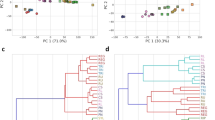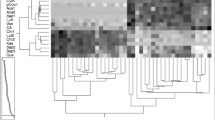Abstract
Mango blossom malformation, caused by infection of mango panicles and young shoots by Fusarium species, leads to significant reductions in fruit yield. Previously, chemometric models were established that allowed biomarkers associated with resistance in tolerant cultivars to be identified. High concentrations of these biomarkers, mangiferin, maclurin and maclurin O-galloyl-glucoside, are inherent genetic traits of some cultivars and have been linked to their ability to confine Fusarium infection. In this study, phenolic profiles of mature leaf extracts from cultivars exhibiting different levels of resistance to Fusarium infection were obtained by UPLC-Q-ToF x MS, five tolerant and seven susceptible cultivars. A robust prediction model, was developed that could be used throughout the season to predict the likelihood of new cultivars being susceptible or tolerant towards mango malformation disease. The levels of biomarkers revealed by the models in tolerant and susceptible cultivars were compared and significant differences were observed. These models can serve as an important tool to investigate appropriate cultivars, prior to their introduction to areas prone to the disease.



Similar content being viewed by others
References
Augustyn WA, Botha BM, Combrinck S, Du Plooy GW (2010) Correlation of volatile profiles of twenty mango cultivars with their susceptibilities to mango gall fly infestation. S Afr J Bot 76:710–716
Augustyn WA, Regnier T, Combrinck S, Botha BM (2014) Metabolic profiling of mango cultivars to identify biomarkers for resistance against Fusarium infection. Phytochem Lett 10:civ–ccx. doi:10.1016/j.phytol.2014.05.014
Bashan Y, Okon Y, Henis Y (1987) Peroxidase, polyphenoloxidase, and phenols in relation to resistance against Pseudomonas syringae pv. tomato in tomato plants. Can J Bot 65:366–372
Beckles DM, Roessner U (2012) 5 - plant metabolomics: applications and opportunities for agricultural biotechnology. In: Hasegawa AAM (ed) Plant biotechnology and agriculture. Academic Press, San Diego, pp. 67–81. doi:10.1016/B978-0-12-381466-1.00005-5
Berardini N, Carle R, Schieber A (2004) Characterization of gallotannins and benzophenone derivatives from mango (Mangiferae indica L. Cv. 'Tommy Atkins') peels, pulp and kernels by high performance liquid chromatography/electrospray ionization mass spectrometry. Rapid Commun Mass Spectrom 18:2208–2216
Boccard J, Rutledge DN (2013) A consensus orthogonal partial least squares discriminant analysis (OPLS-DA) strategy for multiblock Omics data fusion. Anal Chim Acta 769:30–39. doi:10.1016/j.aca.2013.01.022
Bylesjö M, Rantalainen M, Cloarec O, Nicholson JK, Holmes E, Trygg J (2006) OPLS discriminant analysis: combining the strengths of PLS-DA and SIMCA classification. J Chemom 20:341–351. doi:10.1002/cem.1006
Chakrabarti DK (2011) Mango malformation. Springer, Germany
Daglia M, Antiochia R, Sobolev AP, Mannina L (2014) Untargeted and targeted methodologies in the study of tea (Camellia sinensis L.). Food Research International 63, Part C:275–289 doi:10.1016/j.foodres.2014.03.070
Eriksson L, Johansson E, Kettaneh-Wold N, Trygg J, Wikstrom C, Wold S (eds) (2006) Multi- and megavariate data analysis. Part 1: Basic principles and applications. Umetrics, Sweden
Fernando IDNS, Abeysinghe DC, Dharmadasa RM (2013) Determination of phenolic contents and antioxidant capacity of different parts of Withania somnifera (L.) Dunal. From three different growth stages. Ind Crop Prod 50:537–539. doi:10.1016/j.indcrop. 2013.08.042
Fukusaki E, Kobayashi A (2005) Plant metabolomics: potential for practical operations. J Biosci Bioeng 100:347–354
Gunnaiah R, Kushalappa AC (2014) Metabolomics deciphers the host resistance mechanisms in wheat cultivar Sumai-3, against trichothecene producing and non-producing isolates of Fusarium graminearum. Plant Physiol Biochem 83:40–50. doi:10.1016/j.plaphy.2014.07.002
Hamzehzarghani H et al. (2008) Metabolite profiling coupled with statistical analyses for potential high-throughput screening of Fusarium head blight in wheat. Can J Plant Pathol 30:24–36
Kumar P, Misra AK, Modi DR (2011) Current status of mango malformation in India. Asian J Plant Sci 10:1–23
Kvas M et al. (2008) Fusarium mangiferae associated with mango malformation in the Sultanate of Oman. Eur J Plant Pathol 21:195–199
Maffei ME, Arimura G, Mithӧfer A (2012) Natural elicitors, effectors and modulators of plant responses. Nat Prod Rep 29:1288–1303
McPherson BA, Mori SR, Opiyo SO, Conrad AO, Wood DL, Bonello P (2014) Association between resistance to an introduced invasive pathogen and phenolic compounds that may serve as biomarkers in native oaks. For Ecol Manag 312:154–160. doi:10.1016/j.foreco.2013.10.009
Mehl F et al. (2014) Differentiation of lemon essential oil based on volatile and non-volatile fractions with various analytical techniques: a metabolomic approach. Food Chem 143:325–335. doi:10.1016/j.foodchem.2013.07.125
Putri SP, Nakayama Y, Matsuda F, Uchikata T, Kobayashi S, Matsubara A, Fukusaki E (2013) Current metabolomics: practical applications. J Biosci Bioeng 115:579–589. doi:10.1016/j.jbiosc.2012.12.007
Ribeiro SMR, Schieber A (2010) Bioactive compounds in mango (Mangifera indica L.). In: Watson R, Preedy V (eds). Bioactive foods in promoting health: fruits and vegetables. Missouri Academic Press, p 507–523
Rymbai H, Rajesh AM (2011) Mango malformation: a review. Life Sciences Leaflets 22:1079–1095
Sellami IH, Maamouri E, Chahed T, Wannes WA, Kchouk ME, Marzouk B (2009) Effect of growth stage on the content and composition of the essential oil and phenolic fraction of sweet marjoram (Origanum majorana L.). Ind Crop Prod 30:395–402. doi:10.1016/j.indcrop.2009.07.010
Singh OP, Usha K, Saboki E, Srivastav M, Dahuja A, Singh B (2012) Enzymatic reactive oxygen species (ROS) scavenging system in mango varieties resistant and susceptible to malformation. Sci Hortic 138:81–89. doi:10.1016/j.scienta.2011.12.031
Triba MN et al. (2015) PLS/OPLS models in metabolomics: the impact of permutation of dataset rows on the K-fold cross-validation quality parameters. Mol BioSyst 11:13–19. doi:10.1039/c4mb00414k
Vermaak I, Hamman JH, Viljoen AM (2010) A rapid spectroscopic method for quantification of P57 in Hoodia gordonii raw material. Food Chem 120:940–944
Wiklund S et al. (2008) Visualization of GC/TOF-MS-based metabolomics data for identification of biochemically interesting compounds using POLS class models. Anal Chem 80:115–122
Wishart DS (2008) Metabolomics: applications to food science and nutrition research. Trends Food Sci Technol 19:482–493
Acknowledgments
The authors thank the National Research Foundation of South Africa (Grant: Thuthuka TTK 1206281755, IUD: 84217) and South African Subtropical Growers’ Association for funding this project. The authors wish to thank Dr. W Chen for the UPLC X MS analysis, Department of Pharmaceutical Sciences, Tshwane University of Technology.
Author information
Authors and Affiliations
Corresponding author
Rights and permissions
About this article
Cite this article
Augustyn, W.A., Combrinck, S. & Regnier, T. Robust chemometric models for screening mango cultivars to predict their resistance against Fusarium infection. Australasian Plant Pathol. 45, 269–277 (2016). https://doi.org/10.1007/s13313-016-0412-9
Received:
Accepted:
Published:
Issue Date:
DOI: https://doi.org/10.1007/s13313-016-0412-9




